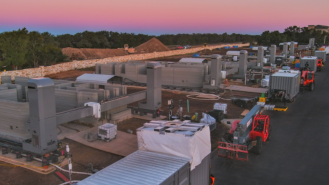Have you always dreamed of owning a technologically advanced, energy efficient home of the future, at an affordable price?
Well that dream could be closer to reality thanks to advances in large-scale 3D-printing capabilities.
Building the housing of the future
A major housing development, built using 3D-printer robots on-site, is taking shape in the US state of Texas. The 100-house project on the outskirts of Austin is the product of a partnership between US house-building giant Lennar, and 3D printing company ICON.
The technology can construct the walls of a new house, including electrical and plumbing systems, around three times faster than traditional building methods, and at up to 30% of the cost, CNBC reports.
“This is the first 100 homes, but we expect to be able to bring this to scale, and at scale we really bring cycle times down and we also bring cost down,” Stuart Miller, executive chairman of Lennar, told the US news network.
The on-site printers are almost fully automated, requiring just three workers to operate them at each home. This less labour-intensive workflow significantly helps to keep costs down.
“The promise of robotic construction is a promise of automation, reducing labor – therefore reducing labour costs,” Jason Ballard, CEO of ICON told CNBC.
Ballard also says the homes bring other advantages, claiming they have “better design, higher strength, higher energy performance and comfort, and increased resiliency.”
How does 3D printing work?
Additive manufacturing, as 3D printing is also known, involves using computer-generated designs to create three-dimensional objects from a digital file, built up layer by layer. Complex shapes can be created easily and it uses less materials than conventional manufacturing methods. As parts and products can be printed on-site, transportation logistics are also reduced.
ICON’s Vulcan construction system consists of a 3D printer and a portable cement-mixing unit which prepares a high-strength building material called Lavacrete. A software platform creates the digital architecture and then controls robotic hardware on-site to slowly build up the structure of the homes. Lennar then installs the roofs, windows and doors.
“In the future, I believe robots and drones will build entire neighbourhoods, towns, and cities. We still have a long way to go, but I believe this marks a very exciting and hopeful turn in the way we address housing issues in the world,” said Ballard.
Could 3D printing help solve America’s housing crisis?
The US had an estimated housing shortage of almost 4 million units at the end of 2020, up from 2.5 million in 2018. In recent years, a spike in raw material costs contributed to a slowdown in housebuilding, with the price of lumber increasing by 150% during the pandemic, according to the US mortgage corporation Freddie Mac.
Meanwhile, 3D concrete printing (3DCP) is expected to help alleviate many of the challenges faced by the construction industry, according to the US Department of Housing and Urban Development.
It says there are several other potential benefits of 3DCP over conventional concrete construction. These include precise and predictable building outcomes, allocating labour to more skilled tasks and increasing worker safety.
Managing the future of 3D printing
The World Economic Forum’s Trade Tech initiative aims to understand how Fourth Industrial Revolution technologies can facilitate global trade and develop forward-looking policy and business strategies. In its report on the impact of 3D printing on business, the Forum says that along with the internet of things and AI, the tech has the potential to enable truly digital manufacturing.
However, although 3D-printing revenues have been growing fast, they still represent only a fraction of global manufacturing revenues of $12.8 trillion.
3D Printing: A Guide for Decision-Makers also highlights the need to monitor and prepare for the impact such technologies may have on the public and private sectors, both positive and negative.
“3D printing might revolutionize the way products are made by disrupting manufacturing patterns, creating novel visual forms that were never possible before, enabling mass customization and offering new pathways to increase the circularity of products,” says the whitepaper.
“At the same time, 3D printing may provoke unintended consequences, such as potential workforce displacement, impacts on trade volumes and supply chains, fiscal and non-fiscal challenges to customs at borders, and room for intellectual property and legal violations.”
This article was reprinted with permission of the World Economic Forum, where it was originally published.
